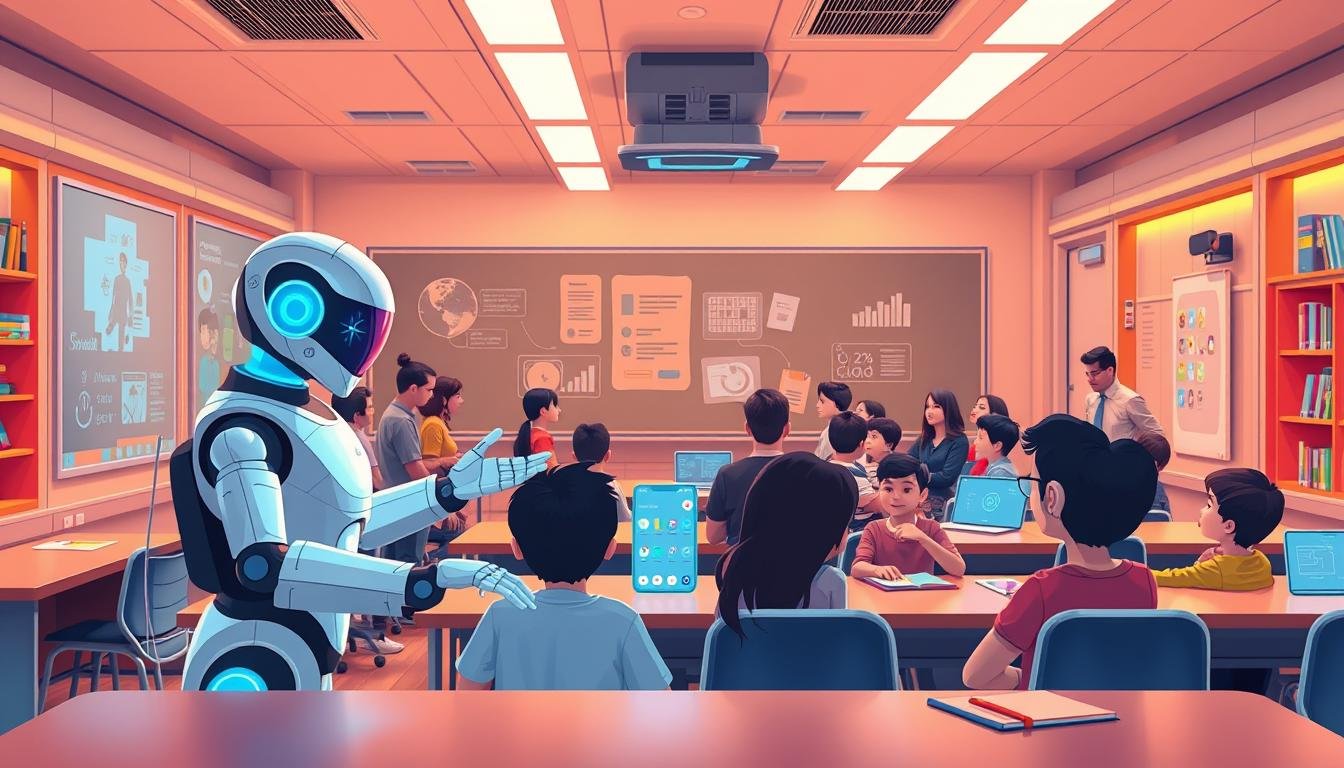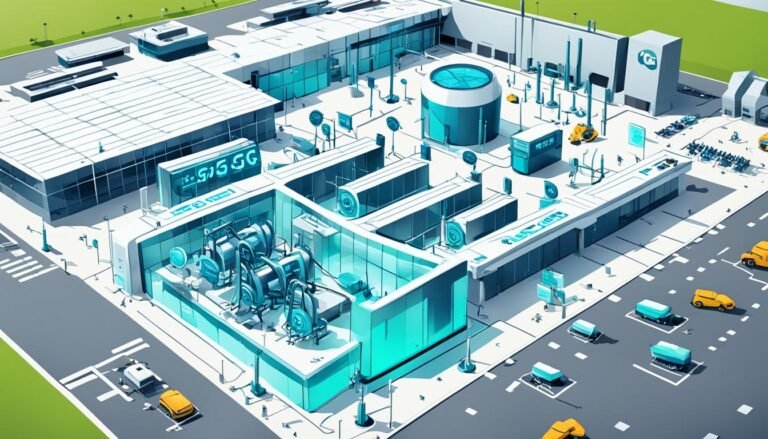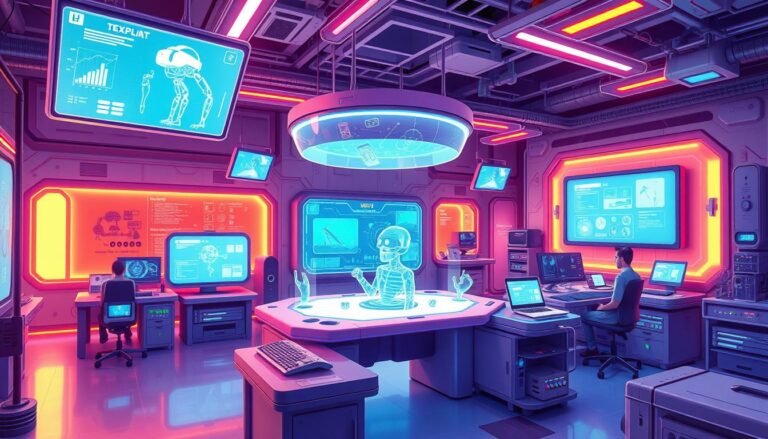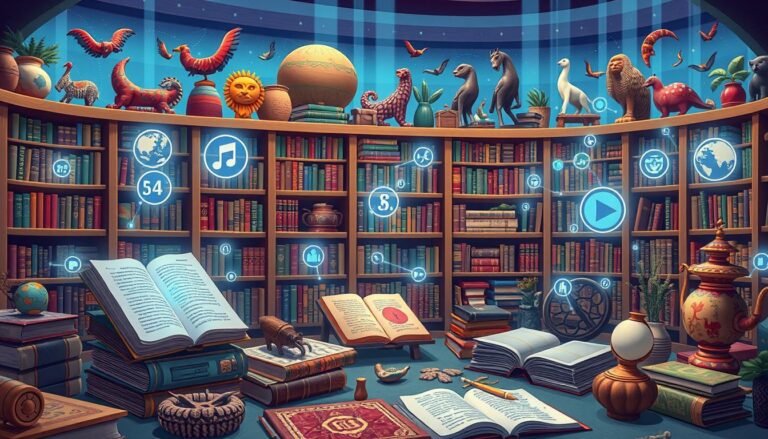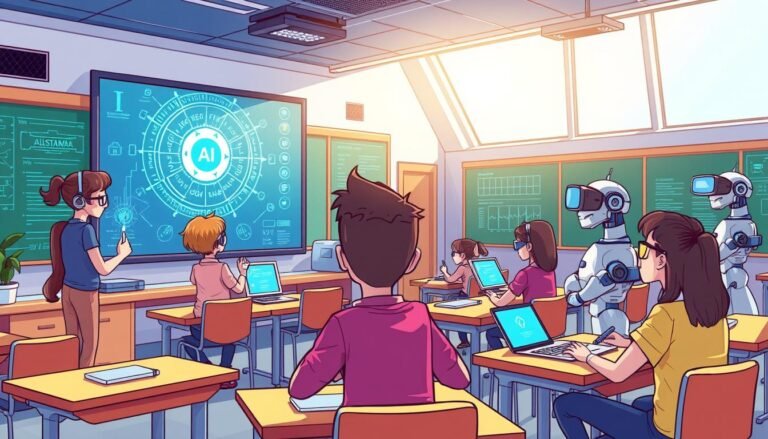The Role of AI Tutors in Personalized Learning
Can artificial intelligence really outdo traditional teachers in making learning personal?
Welcome to a new era where AI teaching assistants are key players in education. Over 47% of learning systems will use AI in the next three years. This shows AI’s big role in schools. Intelligent tutoring systems are changing the game, giving feedback and lessons that fit each student’s needs.
The AI in education market is growing fast, with a 36.0% CAGR from 2022 to 2023. This growth shows how widely AI is being used in schools. Schools that use AI for learning have seen a 62% jump in test scores. This proves AI can really help students learn better.
Nearly 60% of K–12 teachers in the US are using personalized learning. AI in education is more than just a trend. It’s making learning more personal, fun, and fair for everyone.
Key Takeaways
- AI teaching assistants are key to the future of education.
- Intelligent tutoring systems offer personalized and adaptive learning.
- AI in education is growing fast, with big market growth.
- AI programs have improved student test scores and engagement.
- More K–12 teachers in the US are using AI in their classrooms.
Introduction to AI Tutors in Education
AI tutors are changing education, offering new ways to learn. They use machine learning to make learning personal for each student. This means every student gets a tailored learning experience.
Definition and Scope
AI tutors are advanced tools that give personalized lessons and feedback. They adjust learning materials to fit each student’s level and needs. AI can also handle tasks like grading and tracking attendance, freeing up teachers to focus on teaching.
AI tutors offer one-on-one help, which helps students understand tough subjects like math better. This support boosts their performance and confidence.
The Evolution of AI in Education
AI tutors started as simple tools but have grown into complex systems. Now, they can understand and analyze student data in depth. They provide feedback in real-time, helping students fix mistakes and grasp concepts better.
These systems use interactive tools like visual aids and games to make learning fun. This approach makes complex ideas easier to understand and more engaging for students.
| Feature | Benefit |
|---|---|
| Continuous Assessment | Tailors difficulty levels to maintain student engagement |
| Customized Learning Paths | Recommends resources based on individual interactions |
| Adaptive Pacing | Enables students to progress at their own pace |
| Real-Time Monitoring | Provides immediate feedback for mistake correction |
| Dynamic Interaction | Engages students with visual aids and gamification |
| Step-by-Step Guidance | Breaks down complex problems into manageable steps |
| Learning Analytics | Tracks performance and offers proactive support |
| Automated Feedback | Facilitates timely corrections and learning enhancement |
| Scalability | Delivers personalized learning to large numbers of students |
AI-driven learning platforms, like those in Louisiana and NWEA, show how AI can improve education. They make learning personal and effective, boosting student engagement and results.
How AI Tutors Enhance Personalized Learning
AI tutors have changed how we learn. They use smart tech to make learning fit each person’s pace and style. This makes learning more fun and effective.
Adaptive Learning Technologies
AI looks at how well students do and what they’re good at. It shapes lessons to match each student’s needs. This way, learning is always right for you.
Systems adjust how hard things are and what you learn based on how you do. This makes learning a path that’s just for you.
Real-Time Feedback and Support
AI tutors give quick feedback on your work. This helps you learn faster and make fewer mistakes. They also offer help whenever you need it, no matter where you are or what time it is.
Data-Driven Personalized Instruction
AI tutors use lots of data to improve teaching. They make learning plans that focus on what you’re good at and what you need to work on. This way, they help you reach your full potential.
| Feature | Traditional Tutoring | AI Tutoring |
|---|---|---|
| Feedback | Delayed | Instant |
| Customization | Limited | Highly Personalized |
| Accessibility | Limited by location and time | 24/7 On-Demand |
| Adaptability | One-size-fits-all | Adjusts to Learning Pace |
AI tutors make learning fit you perfectly. This makes education more accessible and effective for students everywhere.
Benefits of AI-powered Tutoring Systems
AI-powered tutoring systems bring many benefits to modern education. They make learning more engaging, improve results, and reach more students. Let’s dive into these advantages.
Improving Student Engagement
These systems boost student interest by offering content that fits their learning style. They use fun methods like games and instant feedback. For example, Duolingo keeps users hooked with rewards and AI.
Optimizing Learning Outcomes
They help students reach their full potential. AI adjusts teaching based on how students interact. This way, it spots gaps and speeds up or slows down learning as needed. Cognitive Tutor by Carnegie Learning is a great example.
Accessibility for Diverse Learners
AI systems make education inclusive for all. They use tech like text-to-speech for students with disabilities. This ensures everyone gets quality education, meeting the SDGs for inclusive learning.
The Role of AI Tutors in Personalized Learning
AI tutors are changing how we learn, using adaptive learning technologies and intelligent tutoring systems. They act as personal learning assistants, tracking students’ progress and suggesting areas to improve. This makes learning more efficient.
AI tutors give instant feedback, helping students quickly fix mistakes. This speeds up learning and makes it more fun and interactive. They also adjust lessons to fit each student’s needs and learning style, making education more personal.
These systems offer flexibility, one-on-one attention, and are always available. They help teachers by taking over routine tasks. This lets teachers focus on important things like teaching character and mentoring.
AI tools look at lots of student data to find out what they’re good at and what they need to work on. This way, every student gets the right help, no matter how they learn best. But, we must watch out for biases in how they suggest learning paths.
In short, using AI tutors in learning is all about working together with technology and people. It makes learning better and keeps the human touch important in education. It’s key to keep data safe and tell parents and students how it’s used.
Real-World Applications of AI in Education
Artificial intelligence is changing education, offering solutions that meet each student’s needs. This section looks at popular AI tutoring platforms. It also shares success stories, showing how AI improves learning.
Popular AI Tutoring Platforms
Many intelligent tutoring systems are leading the way in education. They adapt to each student’s learning style and pace. Some notable platforms include:
- DreamBox: This platform focuses on math, offering lessons that match each student’s learning path.
- Knewton: Known for its data analysis, Knewton Alta tracks student performance and finds learning gaps. It ensures personalized learning.
- Squirrel AI: In China, Squirrel AI uses advanced algorithms for custom learning plans. This boosts students’ grades.
- Carnegie Learning: This system uses AI for math tutoring. It predicts student performance and gives tailored exercises, leading to better test scores.
Case Studies and Success Stories
AI’s impact on education is clear in many success stories worldwide. McKinsey found that AI learning platforms can improve student engagement by up to 50%. This shows AI’s power in keeping students interested in learning.
In China, Squirrel AI has seen a 30% increase in student performance in some subjects. In the UK, Third Space Learning uses AI for one-on-one math tutoring. This helps students reach learning goals faster than usual methods.
The future of AI in education is bright, with the market expected to hit $20 billion by 2025. This growth shows more schools will use AI. As AI becomes more common, we’ll see better student results and more engagement.
Challenges and Ethical Considerations
AI in education has made big strides, but it also brings up many ethical and practical issues. One big worry is ethical AI use in education, especially when it comes to keeping student data safe. For example, 70% of educational AI systems store student data in a way that’s not secure. This has led to privacy breaches in 20% of cases.
AI systems can also carry and even make biases worse. Studies show that AI in education can be unfair to 25% of students, often those from underprivileged groups. It’s important to tackle this bias to avoid AI from making stereotypes or discrimination worse. The European Union (EU) has stressed the need for clear AI algorithms to stop unfair treatment.
Another big problem is that not all schools have access to AI technologies. This makes the gap between rich and poor schools even bigger. Only 60% of schools have the tech needed for AI-based learning, showing the inequality. Students in remote areas or with health issues, making up 15% of AI users, are hit the hardest.
AI can also hurt the bond between teachers and students. Using AI tutors in 40% of schools can make 50% of students less skilled in social interactions. The focus on tech might take away from the importance of human connection in learning.
AI’s decision-making processes are also hard to understand. In 70% of schools, AI is a “black box,” leading to distrust among educators, students, and parents. About 60% of teachers struggle to explain how AI algorithms work, which is key for building trust.
Finally, laws and policies need to catch up with AI’s fast growth. Around 75% of people want stricter rules to protect student data and ensure fairness. But making policies for AI in education is tough, with 80% of schools finding it hard to balance new tech with safety. We need clear guidelines that include bias checks, open algorithms, and fair access to AI, along with training for teachers.
| Challenge | Impact |
|---|---|
| Data Privacy and Security | 70% of AI systems store data insecurely; 20% privacy breaches |
| Bias and Fairness | AI bias against 25% of students from marginalized backgrounds |
| Access and Equity | Only 60% of schools with adequate AI technology; 15% of remote/health-affected students use AI |
| Teacher-Student Relationships | 40% of schools concerned; 50% of students’ social skills development hindered |
| Transparency | 70% of schools use “black box” AI systems; 60% of educators struggle to explain AI decisions |
| Regulations | 75% advocate for stricter policies; 80% find balancing innovation and protection challenging |
Conclusion
AI tutors are changing the way we learn. They use advanced tech like machine learning and natural language processing. This makes learning more personal and fun.
These tools give real-time feedback and adapt to each student’s needs. They help students learn better and stay interested. This is a big step forward in education.
AI also helps teachers by giving them useful insights. It makes learning easier and more engaging. Students get to use cool tools like visuals and games.
But, there are challenges and ethical issues to consider. We need to protect student data and make sure everyone has access. Teachers also need training to use these tools well.
The future looks bright with AI in education. We might see even more advanced tools, like VR and AR. Together, humans and AI will make learning exciting and focused on students.
Source Links
- The Role of AI in Personalized Learning
- The Role of AI in Personalized Learning – Just Think AI
- The role of AI in modern education
- AI in Education: Personalized Learning and Intelligent Tutoring Systems
- Council Post: The Role Of AI In Shaping The Future Of Education
- AI-Assisted Tutoring: The Future Of Personalized Learning Support
- The Potential of AI in Personalized Learning | Atlantic International University
- Artificial intelligence in intelligent tutoring systems toward sustainable education: a systematic review – Smart Learning Environments
- How AI tutoring personalizes learning for students
- Revolutionizing Education: AI’s Impact on Tutoring and the Role of Workee AI
- The Role of AI Tutors in Personalized Learning
- The Rise of AI Tutors: Personalized Learning Partner or Education Overhaul?
- The Role of AI in Personalizing Education: How Tech is Changing Learning
- The Ultimate Guide to AI in Education: Benefits, Challenges, & Real-World Uses
- AI in Education: 39 Examples
- Artificial intelligence in education: Addressing ethical challenges in K-12 settings
- Research Guides: Artificial Intelligence (AI) in Education: AI and Ethics
- AI and Personalized Learning in High School
- AI Tutors Revolutionizing Personalized Learning
- JZero Solutions – The Role of AI in Personalized Learning: Tailoring Education to Every Student

